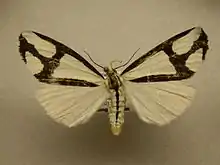Haploa contigua
Haploa contigua, the neighbor moth, is a moth of the family Erebidae. It was described by Francis Walker in 1855. It is found in eastern North America,[2] from Quebec to the mountains of Georgia and west to South Dakota, Arkansas and Mississippi.[3]
| Neighbor moth | |
|---|---|
 | |
| Scientific classification | |
| Kingdom: | Animalia |
| Phylum: | Arthropoda |
| Class: | Insecta |
| Order: | Lepidoptera |
| Superfamily: | Noctuoidea |
| Family: | Erebidae |
| Subfamily: | Arctiinae |
| Genus: | Haploa |
| Species: | H. contigua |
| Binomial name | |
| Haploa contigua | |
| Synonyms | |
| |
The wingspan is 36–49 mm. The forewings are cream to whitish with some brown lines. The inner borders of the forewings are edged with brown. Adults are on wing from late May to early August.[4] There is one generation per year.
Larvae have been recorded feeding on the leaves of Corylus americana. The species overwinters in the larval stage.[5]
References
- Moth Photographers Group. Mississippi State University.
- Savela, Markku. "Haploa contigua (Walker, 1855)". Lepidoptera and Some Other Life Forms. Retrieved January 27, 2018.
- Butterflies and Moths of North America
- BugGuide
- Bug Life Cycles - Documenting the life cycles of insects
- Pitkin, Brian & Jenkins, Paul. "Search results Family: Arctiidae". Butterflies and Moths of the World. Natural History Museum, London.
This article is issued from Wikipedia. The text is licensed under Creative Commons - Attribution - Sharealike. Additional terms may apply for the media files.
